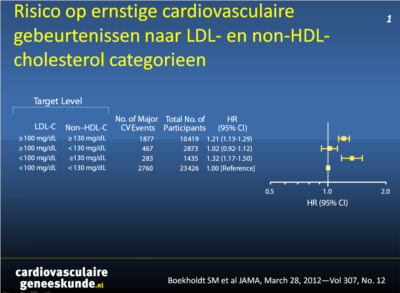Non-HDL-c sterkste voorspeller voor HVZ tijdens statine behandeling
Literatuur - Boekholdt SM et al, JAMA. 2012 Mar 28;307(12):1302-9Association of LDL cholesterol, non-HDL cholesterol, and apolipoprotein B levels with risk of cardiovascular events among patients treated with statins: a meta-analysis
Boekholdt SM, Arsenault BJ, et al.
JAMA. 2012 Mar 28;307(12):1302-9.
Bij patiënten die worden behandeld met statines zijn on-treatment niveaus van non-high-density lipoproteïne (non-HDL) cholesterol waarschijnlijk het beste voor het voorspellen van toekomstige cardiovasculaire gebeurtenissen. Resultaten suggereren dat non-HDL-cholesterol mogelijk een geschikt doelwit is voor behandeling met een statine dan LDL-cholesterol.
Achtergrond
In de huidige richtlijnen worden LDL-C waarden gebruikt als primair doel voor lipidenverlagende therapie. Deze meta-analyse onderzocht of het verband van non-HDL-C en apoB met cardiovasculaire risicofactoren sterker was dan dat van LDL-C.
Methodes
Individuele patiëntgegevens werden verkregen voor 62.154 patiënten van 8 studies gepubliceerd tussen 1994 en 2008.
Belangrijkste resultaten
Gecorrigeerde hazard ratio's voor belangrijke cardiovasculaire gebeurtenissen per 1-SD-stijging waren als volgt:- LDL cholesterol: 1.13 (95% CI 1.10 tot 1.17)
- Non–HDL cholesterol: 1.16 (95% CI 1.12 tot 1.19)
- Apolipoprotein B: 1.14 (95% CI 1.11 tot 1.18)
Conclusie
Onder statine behandelde patiënten had non-HDL-cholesterol een sterkere associatie met het risico op ernstige cardiovasculaire gebeurtenissen dan LDL-cholesterol. Veranderingen in non-HDL cholesterol verklaarden ook een groter deel van het atheroprotectieve effect van statine interventie dan LDL-cholesterol en apolipoproteïne B deden.Abstract
CONTEXT: The associations of low-density lipoprotein cholesterol (LDL-C), non-high-density lipoprotein cholesterol (non-HDL-C), and apolipoprotein B (apoB) levels with the risk of cardiovascular events among patients treated with statin therapy have not been reliably documented.OBJECTIVE: To evaluate the relative strength of the associations of LDL-C, non-HDL-C, and apoB with cardiovascular risk among patients treated with statin therapy.
DESIGN: Meta-analysis of individual patient data from randomized controlled statin trials in which conventional lipids and apolipoproteins were determined in all study participants at baseline and at 1-year follow-up.
DATA SOURCES: Relevant trials were identified by a literature search updated through December 31, 2011. Investigators were contacted and individual patient data were requested and obtained for 62,154 patients enrolled in 8 trials published between 1994 and 2008.
DATA EXTRACTION: Hazard ratios (HRs) and corresponding 95% CIs for risk of major cardiovascular events adjusted for established risk factors by 1-SD increase in LDL-C, non-HDL-C, and apoB.
RESULTS: Among 38,153 patients allocated to statin therapy, 158 fatal myocardial infarctions, 1678 nonfatal myocardial infarctions, 615 fatal events from other coronary artery disease, 2806 hospitalizations for unstable angina, and 1029 fatal or nonfatal strokes occurred during follow-up. The adjusted HRs for major cardiovascular events per 1-SD increase were 1.13 (95% CI, 1.10-1.17) for LDL-C, 1.16 (95% CI, 1.12-1.19) for non-HDL-C, and 1.14 (95% CI, 1.11-1.18) for apoB. These HRs were significantly higher for non-HDL-C than LDL-C (P = .002) and apoB (P = .02). There was no significant difference between apoB and LDL-C (P = .21).
CONCLUSION: Among statin-treated patients, on-treatment levels of LDL-C, non-HDL-C, and apoB were each associated with risk of future major cardiovascular events, but the strength of this association was greater for non-HDL-C than for LDL-C and apoB.


Deel deze pagina met collega's en vrienden: